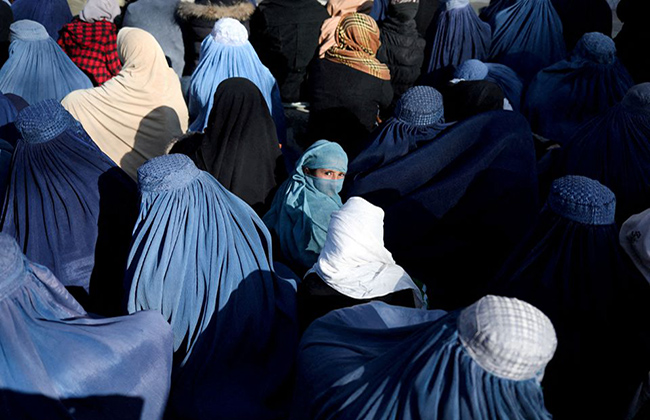
The subjugation of the human rights in Taliban-ruled-Afghanistan has reached fever pitch with a new decree demanding that all women including television presenters wear masks and cover their whole body from eyes or face the wrath of the law.
Barely a year- since usurping power-the Taliban has autocratically flexed its muscle and demands that all women must adhere to its: “final and non-negotiable” order. All female TV presenters must cover their faces while on air or risk being punished-including imprisonment for flouting the law.
The unflinching decree by the autocratic Taliban regime, effective 21May embraces all women other than media practitioners to adhere to the non-negotiable order and besides covering their bodies should ‘only leave their home only when necessary and must be accompanies by male relatives.
Another decree bars girls from attending school after their sixth grade, reversing previous promises by Taliban officials that girls of all ages would be allowed an education. Education authorities have resorted to teaching children in secrecy to avoid being arrested for flouting the decree
The penalties range from summons and are being escalating to court hearings and jail time. It is not clear on the time frame for incarceration.
Akif Mahajar, the spokesman for the Taliban’s Ministry of Vice and Virtue, is cited by Reuters directing all television broadcasters to ensure they cover their faces when on air effective Saturday 21 May.
“Yesterday we met with media officials… they accepted our advice very happily,” Mahajar added: “The last date for face covering for TV presenters is May 21,”
And a statement sent to the Moby Group, owners of popular news agency- Tolo and several other TV and radio networks, according to reports from local media, confirmed receipt warning that the decree applied to other Afghan media as well.
Another unnamed local media official confirmed his station had received the order and was told it was not up for discussion. The station had no other option, he stated while pleading for anonymity to reparations from the authorities.
Meanwhile several female anchors and presenters had posted their photos on social media showing themselves with their faces covered with face masks while they presented programmes.
One prominent Tolo presenter, Yalda Ali, posted a video of herself putting on a face mask with a caption: “A woman being erased, on orders from the virtue and vice ministry.”
On one station, Shamshad TV, implementation of the order was mixed. One female anchor appeared with a face mask on Thursday, while another later in the day went without, showing her face.
The course of action from the new Taliban regime stems from similar autocratic actions imposed during the first stint from 1996-2001. The Taliban had then imposed overwhelming restrictions on women.
The authorities demanded that all women wear the all-encompassing burqa that even covered the eyes with a mesh and barring them from public life and education.
After they seized power again in Afghanistan in August last year, the Taliban initially appeared to have moderated somewhat their restrictions, not announcing a dress code for women.
But in recent weeks, they have taken a sharp, hardline pivot that has confirmed the worst fears of rights activists. Earlier this month, the Taliban ordered all women in public to wear head-to-toe clothing that leaves only their eyes visible.
The dark cloud cast on media practitioners in that country remains a threat to press freedom, human right campaigners and media lobby groups argue. They seek a stop to the escalating abuses.
Reporters without Borders (RSF) and the Afghan Independent Journalists Association (AIJA), in a joint survey shows a radical change in the Afghan media landscape since the Taliban took power last year.
A total of 231 media outlets have had to close and more than 6,400 journalists have lost their jobs since 15 August 2021. Women journalists have been hit hardest, with an average four out of five no longer working.
A survey by RSF and its local partner, the AIJA notes further that since the takeover, the impact on Afghanistan’s media has been dramatic. More than four out of every ten media outlets have disappeared and 60% of journalists and media employees are no longer able to work.
Women have suffered much more than men: 84% of them have lost their jobs. The figures for the previous situation come from a survey of the media and journalists operating in Afghanistan that was carried out before the Taliban took control of the country.
The acts of impunity by the new order have attracted the attention of the United Nations human rights defenders. The High Commissioner for Human Rights says there was “fear and dread” across Afghanistan, which had driven people to flee their homes.
Women have been flogged and killed in areas overrun by the extremists, while journalists and human rights defenders had also been attacked and killed.
War crimes
Reports of violations that “could amount to war crimes and crimes against humanity” have emerged, including “deeply disturbing reports” of the summary execution of surrendering government troops. Since 9 July last year in four cities alone – Lashkar Gah, Kandahar, Herat and Kunduz – at least 183 civilians have been killed and 1,181 injured, including children.
The UN Children’s Fund (UNICEF) also has a voice of concern. There is a rapid escalation of violations against children in Afghanistan, following the deaths of 27 children in the country and 136 injured recently.
Even before the latest Taliban military offensives on urban centres, the UN had documented a steep increase in civilian casualties, a UN report says.




